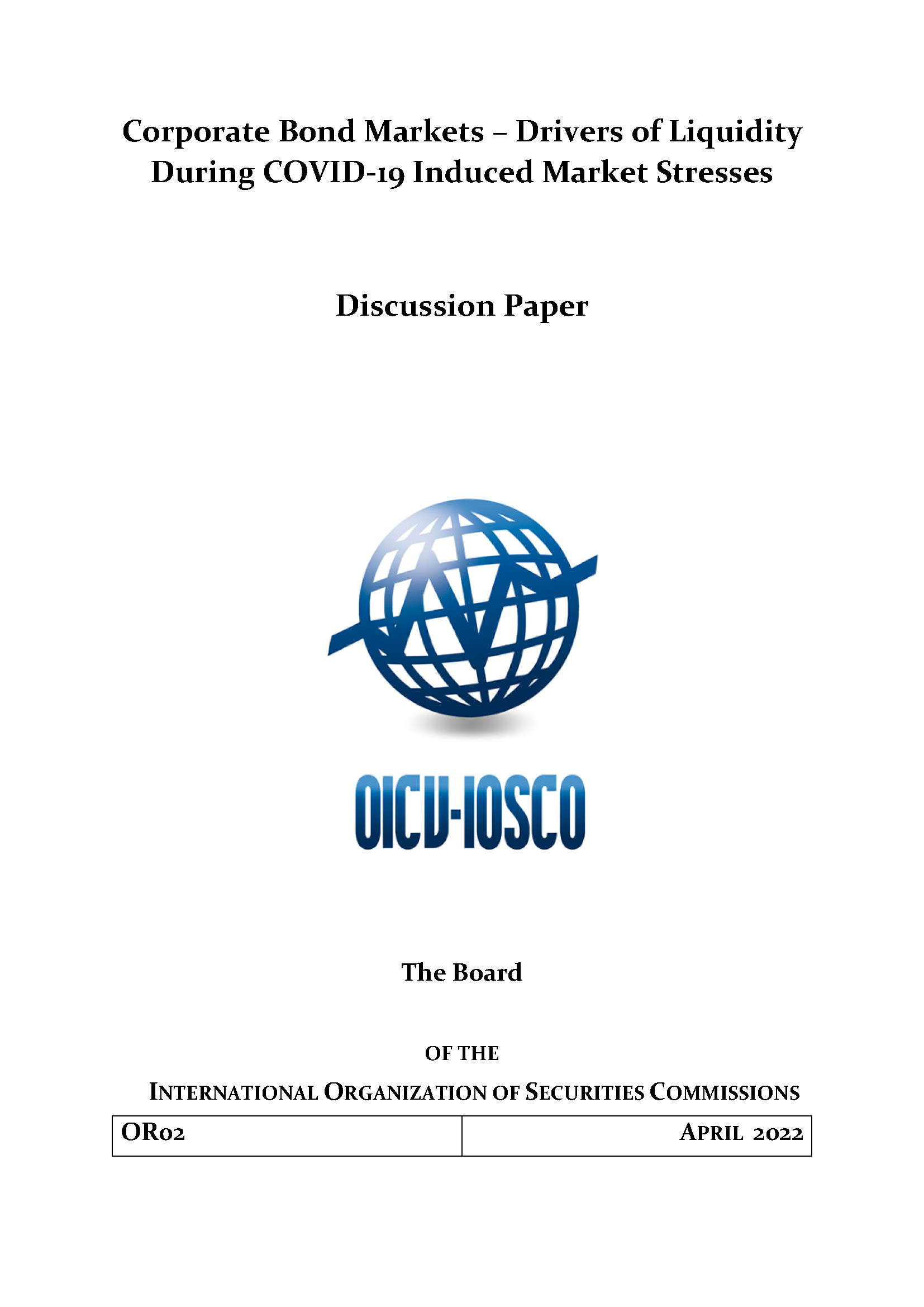
BIX ARTICLE
Corporate Bond Markets – Drivers of Liquidity During COVID-19 Induced Market Stresses
Dec 06, 2022
|
4 min read
Featured Posts
Social Bonds Illustrative Use-Of-Proceeds Case Studies Coronavirus
Jul 06, 2020
|
2 min read
Sustainable Banking Network (SBN) Creating Green Bond Markets
Jul 06, 2020
|
2 min read
Why is Inflation Making a Big Comeback After Being Absent for Decades in the U.S.?
Mar 24, 2022
|
7 min read
SC issues Corporate Governance Strategic Priorities 2021-2023
Mar 29, 2022
|
3 min read

Purpose of discussion paper.
This report summarizes the results of IOSCO’s analysis and solicits views from stakeholders on the key outcomes described below. Specifically, IOSCO is interested in stakeholders’ feedback on possible ways to help improve market functioning and liquidity provision, such as assessing the feasibility, benefits and costs of mitigating shifts in liquidity demand and alleviating supply side market constraints, including the potential unintended consequences from any prospective market changes. Possible areas of further inquiry, as raised by industry and academia during the development of this report, include analyzing whether there could be greater use of “all-to-all” trading or ways to reduce the frictions currently inhibiting its wider use. This might include consideration of improving price transparency in corporate bond markets and a further exploration of the benefits, drawbacks, and practicality of reducing heterogeneity of bonds and increasing standardization.
IOSCO would also be interested in stakeholders’ perspectives on how to advance the quantity, quality, and availability of public and private data. Consistent, comparable data is a critical component for market participants, central banks, and regulators alike, allowing them to trade and monitor markets fairly, efficiently, and effectively, particularly during times of stress.
Key discussion questions are included under each section of the report.
Who will be interested in this discussion paper?
This report will interest a broad audience, including direct and indirect market participants, credit rating agencies, and academia.
The report is organized around four sections.
Section A provides background information and a brief description of the main features of the corporate bond markets.
Section B includes a summary of the Phase 1 outcomes with respect to the state of liquidity during the March stress. Liquidity is measured along three dimensions: (1) primary issuances levels, (2) secondary market trading volumes; and (3) the prices or implied costs of executing secondary market transactions in corporate bonds.
Section C analyses the supply of and demand for liquidity. This includes analyzing how market participants, namely long-term investors such as insurance companies and pension funds, as well as asset managers and hedge funds, drove the demand for liquidity during the COVID-19 market stress. On the supply side, this section looks at the behavior of dealers,4 the drivers for their behavior, and their role in supplying liquidity to the market. Section D also touches on the role of central banks and other large official sector participants.
The report concludes with Section D, an analysis of corporate bond market structure. This section investigates how the evolution of corporate bond markets, including its structural features, have impacted the provision of liquidity. The section first looks at the recent evolution of the corporate bond market microstructure, focusing on the key features of the traditional dealer-based model that uses bilateral over-the-phone “voice” model to connect investors and dealers (versus multilateral Request-for-Quote (RFQ) platforms). The report then looks closer at specific elements of market structure, such as bond heterogeneity, standardization, electronification, trading characteristics, and transparency.
Full Report: Corporate Bond Markets – Drivers of Liquidity During COVID-19 Induced Market Stresses
Disclaimer
The information provided in this report is of a general nature and has been prepared for information purposes only. It is not intended to constitute research or as advice for any investor. The information in this report is not and should not be construed or considered as an offer, recommendation or solicitation for investments. Investors are advised to make their own independent evaluation of the information contained in this report, consider their own individual investment objectives, financial situation and particular needs and should seek appropriate personalised financial advice from a qualified professional to suit individual circumstances and risk profile.
The information contained in this report is prepared from data believed to be correct and reliable at the time of issuance of this report. While every effort is made to ensure the information is up-to-date and correct, Bond and Sukuk Information Platform Sdn Bhd (“the Company”) does not make any guarantee, representation or warranty, express or implied, as to the adequacy, accuracy, completeness, reliability or fairness of any such information contained in this report and accordingly, neither the Company nor any of its affiliates nor its related persons shall not be liable in any manner whatsoever for any consequences (including but not limited to any direct, indirect or consequential losses, loss of profits and damages) of any reliance thereon or usage thereof.
YOU MAY ALSO LIKE
ARTICLE
Dec 07, 2022
|
4 min read
ARTICLE
Dec 06, 2022
|
4 min read
ARTICLE
Nov 10, 2021
|
13 min read
ARTICLE
Jan 08, 2019
|
6 min read


